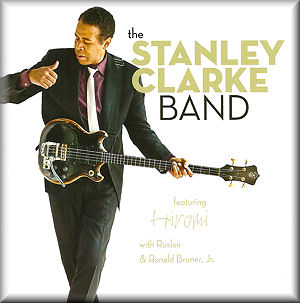1. Soldier
2. Fulani
3. Here's Why Tears Dry
4. I Wanna Play for you Too
5. Bass Folk Song No. 10
6. No Mystery
7. How is the Weather Up There?
8. Larry Has Travelled 11 Miles and Waited a Lifetime for the Return of Vishnu's Report
9. Labyrinth
10. Sonny Rollins
11. Bass Folk Song No. 6 (Mo Anam Cara)
Stanley Clarke - Electric bass, acoustic bass, Alembic bass guitar, talk box, vocals
Ruslan Sirota - Acoustic piano, electric piano, synthesiser, vocals
Charles Altura - Electric guitar
Ronald Bruner Jr. - Drums
Armand Sabal-Lecco - Electric bass guitar (track 2)
Chris Clarke - Drum programming (track 2)
Jon Hakakian - Programming (tracks 2, 5), drum programming (track 3)
Felton Pilate - Keyboards (track 3)
Rob Bacon - Electric guitar (track 10)
Hiromi - Acoustic piano (tracks 6, 8, 9)
Bob Sheppard - Tenor sax, soprano sax (tracks 8, 10)
Cheryl Bentyne - Vocals (track 10)
Doug Webb - Saxophone (track 10)
Andrew Lippman - Trombone (track 10)
John Papenbrook - Trumpet (track 10)
Lorenzo Dunn - Bass synthesiser
Natasha Agrama, Ilsey Juber - Vocals (track 1)
In reviews of previous Stanley Clarke albums, I have traced the resurgence in Clarke's work after a period when he seemed to be lost to the jazz world, turning his attention to writing film scores. This new CD continues the renaissance. The front cover says "Featuring Hiromi with Ruslan and Donald Bruner Jr." Hiromi is the Japanese-born pianist who featured in last year's Stanley Clarke Trio album
Jazz in the Garden, while keyboardist Ruslan Sirota and drummer Ronald Bruner Jr. were both on Stanley Clarke's
Toys of Men album.
The line-up suggests a varied mixture, and that is exactly what you get ofrom this new album. Actually Hiromi only appears on three tracks, starting with Chick Corea's intricate but extremely beautiful No Mystery, which opens as delicately as Chick's original version but Clarke's punchy bass guitar makes it heavier later. Hiromi is also on the mysteriously-titled Lenny Has Travelled 11 Miles and Waited a Lifetime for the Return of Vishnu's Report, which hides the names of at least half-a-dozen groups and artists who were prominent in the birth of jazz fusion. Hiromi's contribution tends to take second place to Charles Altura's guitar, Clarke's bass and Bruner's drums, but it is a captivatingly vivacious piece. Hiromi is more conspicuous in Labyrinth (her own composition), a twisting, turning tune.
Stanley Clarke wrote all but three of the remaining numbers. Outstanding among these are Here's Why Tears Dry, where Clarke's passionate bass evokes affirmation as well as poignancy; Sonny Rollins, a heartfelt St Thomas-style tribute to the tenor-saxophonist with whom Stanley was delighted to play; and the two Bass Folk Songs, which show how Stanley can make the bass guitar sound like a front-line instrument. His only composition which doesn't ring true is How is the Weather Up There?, which is announced by a disembodied voice as "a song about global warming" - rather incongruously played on a mass of electronic instruments when it surely deserves to be an acoustic piece if it is sincere.
The tunes not by Clarke or Hiromi are Ruslan Sirota's fervent Soldier (the sleeve-note points out that "There are 27 armed conflicts going on in the world right now!"); the Corea-like Fulani, dedicated to "noble sub-Saharan nomadic shepherds"; and Felton Pilate's I Wanna Play for you Too (which the sleeve rightly describes as "funk uncut").
As in the two albums I reviewed previously, Stanley Clarke here combines instrumental virtuosity, strong rhythms, and a variety of moods to make a compelling album. Rather disappointingly, Stanley says "This is the last electric album I'm going to do for a while".
Tony Augarde
